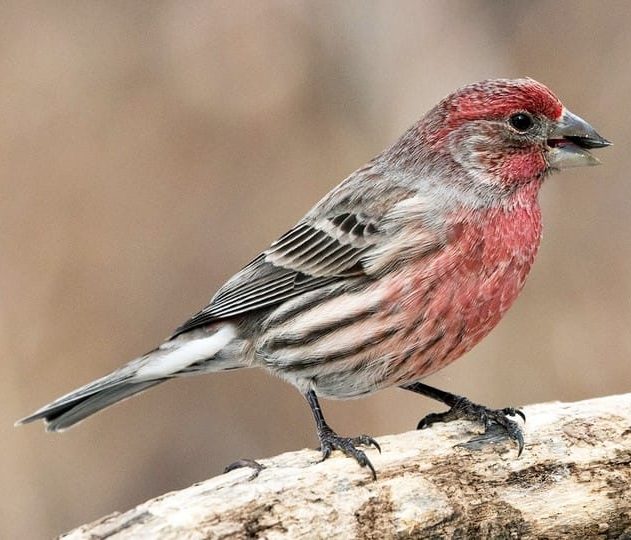Backyard Naturalist: Week #4
Where YOU get to be a naturalist in your own backyard.
by Matt Porter
OAS Staff

Greetings fellow backyard naturalists and welcome to another installment of OAS’ Backyard Naturalist series. You all have been making some great finds out there and receiving your audio clips, video, and pictures of your encounters has been a thrill! The recent spring weather has been bringing heavy winds, colder temps, and rain and may temporarily slow down animal activity in your neighborhood. That being said, I have noticed a continual motivator for birds to brave the weather is the need to find food. With a nest full of offspring many birds are constantly on the hunt for enough food to sustain themselves and their young.
When the weather turns, birds may still be found near feeders and other natural sources of food like conifer pollen and seeds, buds from flowering bushes and trees, and insects on the ground or on plants. Keep your eyes and ears trained in these areas the next time the weather has caused animals to take cover and you might catch a few brave critters out in the open.
Be sure to sign up for our upcoming live backyard naturalist sessions here to share your nature experiences. Until next time, happy observing!
Q & A Recap From Week 3:
Q: Can different foods cause the House Finch to have different plumage color?
A: Bruce found the answer to this question on allaboutbirds.org:
“The red of a male House Finch comes from pigments contained in its food during molt (birds can’t make bright red or yellow colors directly). So the more pigment in the food, the redder the male. This is why people sometimes see orange or yellowish male House Finches. Females prefer to mate with the reddest male they can find, perhaps raising the chances they get a capable mate who can do his part in feeding the nestlings.”

Q: What is this bird that’s nesting under the eave of my house?
A: That is a Northern Flicker. It is a male as indicated by the red “mustache” under its eyes. Click here to read more about this bird and here to hear sounds of the Northern Flicker.
Q: What kind of bird seed do you use?
A: Debbie said she uses a “clean” seed without the husks as much as possible to avoid attracting rats and other pests in her Portland Audubon certified backyard habitat. Black oil sunflower seeds and mixes with millet and other seeds are popular with most of the birds.
OAS Backyard Naturalist Community Observations
- Kadee spotted a male Northern Flicker in her yard in Bend that is nesting by her house. Click here to hear sounds of the Northern Flicker.
- Bruce was able to identify the call of the House Finch in Bend. Click here to hear the sounds of a House Finch.
- Matt saw Chipping Sparrows and Gray Flycatchers in the Ponderosa forests east of La Pine. Click here to hear sounds of the Chipping Sparrow or here for the sounds of a Gray Flycatcher.
- Lauren recognized some Killdeer while out at Tumalo Reservoir. Click here to hear the sounds of a Killdeer.
- male northern flicker
- chipping sparrow
- gray flycatcher
- killdeer

Bird of the Week:
Common English Name: House Finch
Scientific Name: Haemorhous mexicanus
This bird can be found on both sides of the Cascades here in Oregon. The males can often be spotted perching on a tree limb or power line displaying their red head and breasts while broadcasting their wavering song to any would-be mates. The females are a drab brown and less easily spotted, but will most likely be spotted near feeders. You can click here to learn more about the House Finch and here to listen to its song and calls.
Plant of the Week:
Common English Name: Douglas Fir
Scientific Name: Pseudotsuga menziesii

Although this evergreen conifer may not be growing in your backyard, it is likely to be found throughout Oregon including many public parks. There are two varieties, the Coast and Rocky Mountain types that live in coastal and interior mountain ranges across the state respectively. The coast variety grows larger and more quickly and can reach 250 feet in height and six feet in diameter! The “Doug-Fir” is not a true Fir and its name means “false hemlock”. It belongs to its own genus Pseudotsuga or “Douglas-Fir”. The cones of these trees are often key to their identification. This is the Oregon state tree and with good reason since it provides food and shelter to a number of naitve animal species and is a valuable source of timber. Check out the links below for more information on this green giant.
A legend about the particular shape of the Douglas-Fir cone bracts: https://www.savetheredwoods.org/blog/futures/the-douglas-fir-and-the-mouse/
National Wildlife Federation info on the Douglas-Fir: https://www.nwf.org/Educational-Resources/Wildlife-Guide/Plants-and-Fungi/Douglas-Fir
USDA Plant Fact Sheet for the Douglas-Fir: https://plants.usda.gov/factsheet/pdf/fs_psme.pdf
Oregon State University ID info for the Douglas-Fir: https://oregonstate.edu/trees/conifer_genera/spp/doug_fir_spp.html
SERIES INFO
If you are interested in attending this weeks’ live backyard naturalist session and haven’t already registered, please in the link below. Til next week…happy nature observing!










